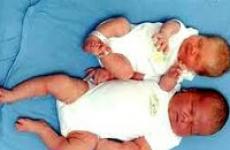How to find out that a female hamster is pregnant. How to find out if a hamster is...pregnant
Rodents have a high ability to reproduce, and they enter the reproductive phase at the age of 3-4 months from birth. How long does pregnancy last for hamsters and how to recognize it are discussed below.
Rodent gestation period
The life cycle of rodents proceeds quickly and lasts on average from 1.5 to 3.5 years, which is influenced by the type of rodent and the quality of care for it. How long pregnancy lasts in hamsters directly depends on the type of pet. The gestation stage takes from 15 to 20 days. It lasts a little longer in Djungarian species, taking from 19 to 22 days. In one litter, a female is capable of producing from 4 to 12 cubs.
The period of feeding babies takes 20 days. The lactating female must be provided with nutritious food and protected from tactile communication with humans in order to prevent the pet from refusing to feed its babies or eat them if it senses a foreign smell. Some animals can eat their young at the call of nature, since instincts are difficult to deceive and are often preserved in domestic rodents. In this case, weakened babies whose chances of survival are very low are at risk.
Determining the pregnancy of an animal
Based on the condition and behavior of a rodent, it is quite difficult to understand its interesting position, but it is quite possible with careful observation of the animal. Initial signs include increased appetite and a constant desire to sleep. Sometimes the opposite reactions occur: the appetite disappears completely, and the animal behaves especially actively.
The second sign is characterized by the preparation of the nest in which the pet intends to raise offspring. The hamster actively arranges its space and strives to expand it as much as possible. Another sign may be the aggressive behavior of the female, which does not depend on external factors such as resentment towards the owner. Animals in this position tend to defend their territory from any outside interference.
Visual signs are manifested in the enlargement of the rodent’s abdomen and nipples, but they can only be recognized in the later stages of gestation, starting from the middle of the cycle. If the animal has long fur, signs can be noticed only before birth. If you know how long pregnancy lasts in hamsters and mark the date of mating on the calendar, you can prepare for childbirth, guided by the numbers, and free yourself from searching for indistinguishable beacons.
How to prepare for childbirth
Having determined how long hamsters are pregnant and having calculated the timing of your rodent, a few days before the birth of the offspring, it is necessary to restore complete order in the cage. The hamster's area needs to be thoroughly cleaned, washed and preferably disinfected. The animal's drinking bowl will require attention. If it is too deep, replace it with a smaller size, eliminating the possibility of small hamsters falling into the water. It is unlikely that they will be able to get out of the drinking bowl on their own or not drown if there is too much water. Finally, treat your pet with paper napkins, from which he will build a cozy nest for the babies.
Caring for the safety of babies
To prevent your pet from eating the babies, try to clean the cage in advance of the birth. After the babies are born, access to the hamster’s home should be limited as much as possible. Do not pick him up for communication, do not try to touch or stroke the offspring. All that is required of the owner is to carefully clean the toilet area and put food in the cage. Place the hamster's house in a quiet and calm place, eliminating the occurrence of anxiety. Several rules will help protect the cubs from the aggressive behavior of the female:
- try to minimize stressful situations;
- do not add other hamsters to the cage;
- provide the rodent with adequate nutrition;
- allow females to give birth between 4 and 12 months of age;
By providing the pet with favorable conditions during gestation and the feeding period, the likelihood of eating its own young can be reduced to zero.
Sexual maturity in hamsters is reached at the age of 6-7 weeks. Pregnancy lasts from 15 to 21 days (Syrian breed), from 18 to 22 days (Campbell breed, Chinese breeds), from 23 to 30 days (Roborovsky hamsters) and becomes visible to you about 10 days before birth. Young animals give birth to fewer offspring than mature females. From 3 to 6 cubs can be born.
Main factors of pregnancy
Before making an unambiguous conclusion about the pregnancy of a hamster, you need to evaluate and compare several factors:
- Your hamster is definitely female. To determine the gender, you need to carefully lift the pet by the area of skin on the back of the neck. In females, pairs of nipples are clearly visible on the abdomen, but in males this is not the case.
- Pregnancy is only possible if the female has had contact with the male no earlier than three weeks, if you count back from that day.
- Due to her age, a female hamster cannot become pregnant before 6 weeks of age.
- Rule out possible diseases that externally (big belly) resemble pregnancy: pyometra (accumulation of pus in the uterus), cancer of internal organs, heart disease, intestinal problems.

Signs that definitely indicate pregnancy
1) Enlarged belly of the pet. If in doubt, watch your belly grow. The belly should only get bigger.
2) The female prepares a place for childbirth and the subsequent stay of the offspring, so the pet’s stealing of available material and the construction of a secluded “nest” will immediately catch your eye.
3) Obvious changes in the activity of the animal's mode. A pregnant hamster behaves calmer and more cautiously and moves more slowly.
Do I need to care for my hamster during pregnancy?
As we have already said, you will see pregnancy literally 1-1.3 weeks before the appearance of the offspring. Once pregnancy is determined, veterinarians advise not to disturb the animal, which needs to prepare for an imminent birth.
But not disturbing the animal does not mean removing the cage out of sight! The cage needs to be cleaned periodically so that at the time of birth the female is in a clean and convenient space for this process.
Feeders must also be clean, food must be regularly replaced with fresh food, and the pet’s diet must be supplemented with vegetables, fruits, and nuts. You can add glucose to the feeder with water (literally a few drops).

Two weeks before the start of labor (if you planned the hamster's pregnancy and you know that the animal is expecting offspring) or 10 days (as soon as pregnancy becomes visible, if you did not plan to produce offspring), move the animal to a separate cage. At the same time, ensure the availability of available material from which the hamster will build a nest (hay, pieces of soft fabric). The pet should be transferred to another cage with extreme caution and care, so as not to create a stressful situation that could affect labor.
You've probably noticed changes in your hamster's behavior over the past few days. One of the possible reasons for changes in the behavior of a female hamster could be pregnancy. Knowing the signs that you should pay attention to, you can not only establish the fact that the female is pregnant, but also ensure the safety of her offspring.
Steps
Part 1
Establishing the fact of pregnancy- Lift your hamster safely by the scruff of the neck (hold him firmly by the area of mobile skin just above the shoulders, but without pinching) and carefully turn your pet over to check his gender. Males have prominent testicles near their tail, which give their rear a rather voluminous appearance, while females have nothing of the sort, instead having much more visible pairs of nipples on their bellies.
- If you have always thought that your hamster is female only because it already had a female name at the time of purchase, it would probably be a good idea to check the gender of your pet yourself.
- Please note that if you suspect your hamster is pregnant due to an enlarged belly, then the female is already at the stage of pregnancy when you should refrain from handling the animal, as rough handling can have a negative impact on the later stages of pregnancy.
-
Find out whether the female had contact with males. The average length of pregnancy in hamsters is 15-21 days, so pregnancy may be possible if the female has been in contact with males in the last three weeks. If she has not been in male company for more than the last four weeks, then she cannot be pregnant.
Consider the age of the hamster. Hamsters can reach puberty as early as 6-7 weeks of age. The only possible exclusion of the possibility of pregnancy due to sexual immaturity can only be made if the hamster is less than six weeks old.
- This also means that you should be careful when keeping hamsters from the same litter if they are approaching six weeks of age, as they may begin to mate. This also applies to keeping a mother female with any males.
-
Rule out possible diseases. An enlarged abdomen may not be a sufficient sign to establish pregnancy. It may be a sign of another disease or condition the hamster is experiencing. Possible diseases that may look similar to pregnancy include the following:
- Pyometra is an infectious disease of the uterus in which pus accumulates in it.
- Enlargement of internal organs such as the liver or spleen, often due to cancer.
- A heart defect can cause fluid to accumulate in the abdomen.
- Intestinal problems and fullness due to poor digestion.
- In addition to those mentioned above, you may notice other signs of possible illness, such as increased thirst (the feeder will empty faster than usual), decreased appetite (note if you have to refill the feeder less often), and decreased fat layer (usually on the ribs).
-
Note the enlarged belly. An enlarged belly may be the first sign of pregnancy, but if it's not obvious to you yet, wait and see if it starts to grow. If the female eats, drinks, maintains normal physical activity and has had the opportunity to mate with a male, then an increase in her abdomen can very likely indicate pregnancy.
Pay attention to the construction of the nest. A pregnant female in the late stages of pregnancy will want to build a nest, so her collection and transfer of bedding to a secluded corner of the cage can also serve as a sign of pregnancy.
See if the female is storing food. A pregnant female may begin to eat more than usual and also store more food by hiding it in the nest. Obviously, this in itself does not confirm the presence of pregnancy, but it allows you to see the overall picture of the situation.
Pay attention to signs of impending labor. The female can become very restless in the very last stages of pregnancy. Signs of impending birth include relentless activity with periodic switching between feeding, licking and nest building.
Take your hamster to the vet. If the above recommendations do not help you, contact your veterinarian to help you determine if your female hamster is pregnant. However, your veterinarian will likely also warn you that even a professional examination can cause stress in the animal, causing the female to abandon or eat her babies.
- If you observe an enlarged abdomen in your hamster for longer than 7-10 days and no labor has occurred (or if the female is not showing any other behavioral signs of pregnancy by this time), be sure to take the animal to the veterinarian, as these may most likely be symptoms of a disease. , not pregnancy.
Part 2
Ensuring the safety of the offspring-
Never touch a female's belly to touch the babies. Pregnant females are very sensitive and, when stressed, are extremely prone to harm their offspring after birth. Feeling the belly by a person is definitely stressful for the female hamster, so it puts the health of the future offspring at risk.
During pregnancy, feed the female with nutritious food. You need to make sure your hamster's diet is healthy and nutritious to ensure healthy babies. Feed the female the food she is used to eating, as a sudden change in diet can lead to abdominal upset. However, the ideal diet option is a rat or mouse pelleted food, since the hamster will not be able to selectively feed, leaving some of the healthy (but less palatable) parts of the regular food uneaten.
Give the female rest from about the thirteenth day after mating. Pregnant female hamsters prefer to be completely alone for at least a couple of days before giving birth. This means that from the thirteenth day after mating you should not touch anything inside the cage, including the bedding. Be as careful as possible when putting fresh food into the cage. Your carelessness may lead to the female eating the newborn offspring.
Determine the gender of your hamster. It is quite obvious that, like in humans, only females can become pregnant in hamsters. Most people initially know the gender of their hamsters, but just in case you don't already, for more information and to determine the gender of your pet, read the article “How to Determine the Sex of a Hamster.”
The parents decided to surprise their child and give him a hamster. The surprise was a success, because instead of one animal there were many at once. The pet store claimed that the acquisition was a young male. It turned out that it was not a male. And the girl is also pregnant.
What to do in such a case? A hamster with children will not be accepted back to the pet store. How to understand that a hamster is pregnant when buying it? Let's find out.
Determination of gender
To avoid getting into the situation described above, you need to be able to distinguish the sex of a hamster. Someone will laugh, saying, what’s so complicated about this? In reality, everything is not so simple. Especially in very small (up to 4 weeks) rodents.
How to determine gender? To do this, the following manipulation is performed. The hamster is placed on the palm of your hand, tummy up. Holding it under the front legs so that the animal does not fall, use your free hand to hold the back of the body and look at the location of the genitals.
If the anus and genitals are far from each other, we have a hamster. If these organs are at a very close distance, we see his girlfriend in front of us.
By the way, the guy’s fur, which covers the primary sexual characteristics, is longer than that of the female representatives.
How is this possible?
Let's say the acquisition turned out to be a hamster lady. The lady lived in the new house for a week, and then gave birth. The owners are shocked. How is that? When did you have time?
In the pet store, hamsters are not separated by gender. Both males and females live together. Often, sellers themselves do not know how to understand that a hamster is pregnant. And considering that these cute little ones are capable of reproducing from the age of 6 weeks, it is quite possible that the little girl you bought has already reached this level.
Dates of pregnancy
How can you tell if your hamster is pregnant? This is very difficult to do at the first stage of an interesting position in a rodent. Pregnancy lasts from 19 to 21 days. The belly begins to appear at about 10 days.
Does the period depend on the breed of rodent?
No. The gestation period for both Dzungarian and Syrian individuals is the same. How can you tell if a dwarf hamster is pregnant? This is easier than discerning a Syrian's preparation for motherhood. Dzungari are smooth-haired comrades, which means they will not be able to disguise their belly under thick fur.
Establishing pregnancy
So, we found out at what age a female is able to become pregnant and how long this period lasts. Now let's find out how to understand that a female hamster is pregnant.

- The first sign is a uniformly rounded belly. But it can only be distinguished from the 10th day of pregnancy.
- The second sign is the sudden and pronounced appearance of the nipples. Typically, a female hamster's nipples are light and pale. During pregnancy, they become bright pink and stand out against the background of the fur.
- The third sign is an increase in appetite. The expectant mother eats everything in her bowl with the energy of a vacuum cleaner. And he looks through the bars of the cage at the owner, waiting for more.
- The fourth sign is a change in behavior. An affectionate and tame girl becomes a real fury. When trying to pick her up, he uses his teeth.
- The fifth sign is nest building. The future hamster mother begins to fuss and build herself a nest from scrap materials.
If the owner notices these signs in his pet, the pet store will sell him a lady with a “surprise”.
Getting ready for childbirth
We found out how to tell if a female hamster is pregnant. How to prepare her for childbirth?
It’s worth starting with the fact that as soon as the owner discovers that his pet has a rounded and growing belly, he will have to do a general cleaning of the cage. Why so early? Because five days before the expected birth, under no circumstances should you irritate the expectant mother by touching her, changing the environment in the cage, or smelling someone else. She may get nervous, think that something is threatening her offspring, and after giving birth she may simply eat the babies.
So, cleaning. How does it happen? We carefully clean the cage of filler and food debris, wash it with a disinfectant and dry it. Then add new litter and clean white napkins or unscented toilet paper. This is necessary so that the female can equip herself with a nest.
The house is washed and returned to the cage. The water bowl and feeder are scalded with boiling water, then sent back to the cage.
The girl needs to be fed intensively. Therefore, it is worth feeding three to four times a day. And not just dry food for hamsters. Fruits, vegetables and the protein component of the diet are necessary.

Make sure there is always clean water in the drinking bowl. Pregnant females have increased thirst, and the drinking bowl may be emptied with enviable regularity.
After childbirth
We talked above about how to understand that a Djungarian hamster is pregnant and so is its Syrian relative. What should the owner do when one morning he discovers pink, very ugly and blind cubs in a cage?

Change the litter and clean the hamsters' territory that has not been cleaned for a long time? In no case. For another couple of weeks, after the pet has become a mother, you will have to forget about cleaning her cage. All because of the foreign smell mentioned above.
The babies should not be touched until they begin to leave the nest on their own. Feed the mother hamster with protein food, monitor the amount of water in the drinking bowl and forget about the hamster family for at least three weeks.

Conclusion
From the article you learned the following points:
- How to understand that a hamster is pregnant.
- How to determine the sex of cute rodents.
- How to help your pet prepare for labor.
- What to do after the birth of babies.
And the very last piece of advice. When babies reach four weeks of age, they are seated according to gender.
If you have two hamsters of different sexes living in the same cage, pregnancy of the female is almost inevitable. It doesn’t matter whether you planned to breed hamsters or whether everything happened due to an oversight - you should know how to care for a female during this period. How it proceeds hamster pregnancy?
It is quite difficult to determine the pregnancy of hamsters by external signs: The belly only gets bigger in the middle of pregnancy, and if the hamster has long hair, it is almost impossible to notice it. Also, mid-pregnancy your nipples may become larger.
Indirect signs of pregnancy may include changes in behavior. Sometimes during pregnancy, affectionate tame hamsters can become aggressive and stop being handled. The opposite also happens: an aggressive and wayward female becomes more docile (although this happens quite rarely).
Also Pregnancy in hamsters may be accompanied by increased appetite and drowsiness, however, sometimes the opposite can be observed: the female becomes more active, and her appetite decreases. Everything is very individual.
If you suspect that the female is pregnant, you need to remove the male from her, if you haven't done this before. Even if the hamsters lived together before (which is the exception rather than the rule), during pregnancy the female will most likely begin to show aggression towards the male. This can end disastrously for both the male and the female (depending on which of them is stronger).
Preferably move the female to an aquarium (terrarium) or a cage with a high tray, which needs to be placed in a quiet, calm place. The fact is that children leaving the nest can fall out of the cage through the bars and die, so it is important to prevent such a development of events.
Hamster pregnancy does not last long: 16-19 days for Syrian hamsters and 19-22 days for Djungarian hamsters. Deviations from this period are extremely rare, so if the female did not give birth within two days after the expected date of birth, there are only two options: either she was not pregnant, or something went wrong. In this case, it is advisable to consult a veterinarian.
In order for hamsters’ pregnancy to proceed normally and the offspring to be born healthy, it is very important to take care of proper nutrition during this period. The diet should be varied, and the proportion of protein foods should be increased.. Typically, hamsters are given animal protein 1-2 times a week. However, pregnancy in hamsters leads to an increase in the need for animal protein, so the female needs to be given daily low-fat cottage cheese, a boiled egg, low-fat boiled chicken without salt and seasonings (one thing, of course, and not all at once). Also a pregnant female should have constant access to fresh water.
During the first 10-12 days of pregnancy, the female can still be picked up (if she does not show aggression towards people), although this is undesirable, and in the later stages it is better not to disturb the hamster. How can you tell when a hamster's pregnancy is coming to an end? Usually the female begins to actively arrange the nest.
About 5 days before the expected end of pregnancy, you need to do a thorough cleaning of the cage.. Rinse and disinfect the cage thoroughly, put in new bedding and some old bedding (so that the cage has a familiar smell). Place a house (if it is spacious enough for a female with offspring), put in fresh food (just do not put perishable foods), and pour clean water into the drinking bowl. It is better to remove deep bowls of water: newborn hamsters can accidentally drown in them. You also need to give the female more toilet paper or clean white napkins without fragrances or dyes so she can build a nest
In the remaining days before giving birth, do not disturb the female under any circumstances., let her arrange the home to her liking. The female will perceive cleaning just before giving birth as destruction of the nest and may even destroy the newborn offspring, because she will not feel safe.
How successful the pregnancy of hamsters will be largely depends on their owners.. If you provide the female with comfortable conditions, then most likely she will safely give birth to healthy offspring. Of course, caring for the female and cubs after birth is also of great importance, which we discussed in the article “Reproduction of hamsters”.






